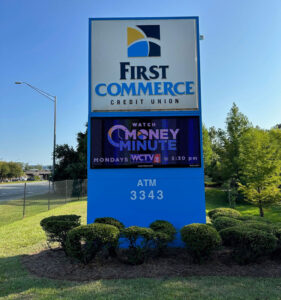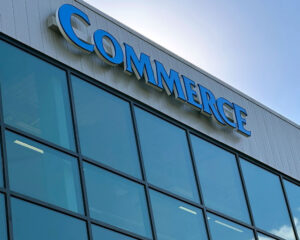
In today’s fast-paced and digitally driven world, effective communication and engaging visual displays have become essential for businesses to capture the attention of their target audience. This is where smart signage, also known as digital signage or dynamic signage, steps in as a powerful solution. Smart signage encompasses a wide array of digital displays and screens that are interconnected within a network, enabling remote control and seamless updates of diverse forms of content. From bustling public spaces and bustling retail stores to dynamic corporate environments and bustling transportation hubs, smart signage has emerged as a versatile and interactive medium to convey information and advertisements to a specific audience.
Gone are the days of static posters and outdated billboards that fail to captivate viewers. Smart signage has revolutionized the advertising and information dissemination landscape, providing businesses with a highly flexible and attention-grabbing platform. By harnessing advanced hardware, software, and networking technologies, smart signage enables businesses to present dynamic and visually appealing content that resonates with their audience. Whether it’s displaying product promotions, wayfinding instructions, corporate communications, or real-time updates, smart signage allows for targeted and tailored messaging that can be updated remotely and in real-time.
In this article, we will delve into the technical intricacies of smart signage, exploring the components that make up a smart signage system and the wide range of applications it serves. From the display devices and media players to the content management systems and network connectivity, we will dissect the underlying technology that drives smart signage networks. Moreover, we will uncover the diverse applications of smart signage in advertising, wayfinding, branding, entertainment, public safety, and beyond. Join us as we unlock the potential of smart signage and discover how it is reshaping the way businesses communicate and engage with their audiences in the digital age.
Technical Components of Smart Signage Systems:
- Display Devices: Display devices are the physical screens or panels used to present visual content in smart signage systems. They come in various sizes and types, including LCD, LED, OLED, and projection-based displays. The choice of display device depends on factors such as the viewing distance, ambient lighting conditions, and desired image quality. For optimal performance, it is important to select a display device that matches the specific requirements
 of the signage environment.
of the signage environment. - Media Players: Media players play a crucial role in smart signage systems as they are responsible for rendering and displaying the content on the screens. These devices can be small computers or specialized hardware designed to decode various media formats and establish connections with the display devices. Media players often operate on popular operating systems such as Android, Windows, or Linux, and they are equipped with networking capabilities that enable them to receive content updates remotely. By efficiently processing and delivering the multimedia content, media players ensure seamless and synchronized playback on the smart signage screens.
- Content Management System (CMS): The Content Management System (CMS) is a software application that plays a pivotal role in smart signage networks by facilitating the management and scheduling of content. It offers a user-friendly interface that empowers users to create, organize, and distribute multimedia content to individual display devices or groups of devices. Through the CMS, users can easily upload images, videos, text, and other media elements, and define playlists and schedules for displaying the content. This central control system ensures efficient content management and seamless delivery, allowing for dynamic and engaging presentations on the smart signage network.
- Network Connectivity: Network connectivity is a vital component of smart signage systems, enabling the distribution and control of content. These systems utilize both wired (Ethernet) and wireless (Wi-Fi, cellular) connections to establish communication between the content management system, media players, and other network components. Through network connectivity, real-time updates, monitoring, and remote management of the signage system become possible. It facilitates seamless content delivery, enables immediate adjustments, and allows for efficient centralized control and oversight of the entire smart signage network.
- Sensors and Interactivity: Sensors and interactivity play a significant role in smart signage systems, as they introduce enhanced viewer engagement and data gathering capabilities. By integrating sensors such as motion sensors, touchscreens, cameras, proximity sensors, and facial recognition systems, smart signage enables interactive experiences that captivate viewers. Moreover, these features facilitate audience measurement, allowing businesses to gather data on viewer demographics and behavior. This data can be leveraged to deliver targeted advertising, tailoring content to specific audiences and maximizing the impact and effectiveness of the signage system.

The Applications of Smart Signage are Diverse and Include:
- Advertising and Promotion: Smart signage plays a pivotal role in advertising and promotion across various settings such as retail stores, shopping malls, airports, and public spaces. Its utilization enables businesses to deliver targeted and dynamic content, providing a platform to showcase products, highlight special offers, and convey brand messaging to potential customers. With smart signage, businesses can tailor their advertising campaigns to specific audiences, ensuring that the content resonates with the viewers’ preferences and characteristics. By delivering visually captivating and interactive content, smart signage creates engaging experiences that attract and captivate the attention of passersby, effectively increasing brand visibility and driving customer engagement. It offers a versatile and adaptable solution for businesses to communicate their marketing messages in a dynamic and impactful manner.
- Wayfinding and Information: Smart signage goes beyond advertising and also serves as a valuable tool for wayfinding and information dissemination in various large venues such as hospitals, museums, and campuses. These digital wayfinding systems help guide visitors through complex environments by displaying interactive maps, directions, and event schedules. With smart signage, users can easily navigate through unfamiliar spaces, enhancing their overall experience. Moreover, smart signage can provide real-time information, keeping individuals informed about important updates such as news, weather conditions, or public transportation schedules. By offering these dynamic and up-to-date details, smart signage contributes to improved convenience, efficiency, and overall satisfaction for visitors in diverse settings.
- Branding and Corporate Communication: Smart signage serves as a powerful tool for branding and corporate communication within companies. In corporate environments, businesses leverage smart signage to showcase branding messages, reinforce brand identity, and communicate internal information effectively. It becomes a visually appealing and engaging medium to disseminate critical messages such as internal announcements, employee communications, and company achievements. By utilizing smart signage, organizations can create immersive and interactive experiences for their employees and visitors, fostering a sense of belonging and keeping everyone informed. This dynamic form of communication enhances engagement, strengthens company culture, and reinforces the overall brand image, making it an invaluable asset for effective corporate communication strategies.

- Entertainment and Digital Menus: Smart signage offers a versatile range of applications in the realm of entertainment and dining establishments. In entertainment venues such as cinemas, theaters, and stadiums, smart signage takes center stage by displaying showtimes, concession menus, promotional videos, and live updates, providing visitors with up-to-date information and enhancing their overall experience. In the realm of dining, smart signage revolutionizes the way menus are presented. Restaurants and fast-food chains can replace traditional static menus with dynamic digital menus that can be easily updated in real-time. This allows for seamless menu changes, special promotions, or limited time offers to be instantly reflected, providing customers with relevant and enticing choices. The engaging and visually captivating nature of smart signage transforms the dining experience, enabling businesses to effectively showcase their offerings and capture customer attention in a dynamic and interactive manner.
- Public Safety and Emergency Messaging: Smart signage holds significant importance in ensuring public safety and delivering emergency messaging in critical situations. During emergencies, such as natural disasters or security incidents, smart signage becomes a vital communication tool for quickly and effectively reaching a large audience. With its dynamic nature, digital signage enables the rapid updates and dissemination of urgent alerts, evacuation instructions, and essential safety information. By strategically placing smart signage in key locations, authorities can swiftly communicate critical messages to guide and protect the public. This dynamic and real-time communication capability of smart signage plays a crucial role in enhancing emergency preparedness, facilitating prompt responses, and ultimately safeguarding lives and minimizing potential risks in times of crisis.
In conclusion, smart signage has revolutionized the way information is delivered, advertisements are displayed, and customer engagement is enhanced in various settings. By leveraging advanced hardware, software, and networking technologies, smart signage offers a versatile and dynamic platform for businesses to communicate with their audiences effectively. Whether it’s captivating advertising, informative wayfinding, interactive experiences, or real-time data display, smart signage provides a powerful tool to engage viewers and create memorable experiences.
The flexibility and scalability of smart signage enable businesses to adapt and tailor their content to specific audiences and contexts. With the ability to remotely manage and update content, businesses can ensure that their messaging remains relevant and up to date, delivering the right information at the right time. Furthermore, the integration of IoT devices, AI technologies, and analytics capabilities opens new possibilities for data-driven insights and personalized interactions, enabling businesses to optimize their signage strategies and improve customer experiences.
As technology continues to advance, we can expect smart signage to further evolve, offering even more innovative features and applications. From retail stores and transportation hubs to corporate environments and public spaces, smart signage has become an integral part of modern communication and engagement. Its ability to captivate, inform, and influence makes it an asset for businesses seeking to make a lasting impression in a digital world. With smart signage, the future of visual communication is brighter than ever before.






